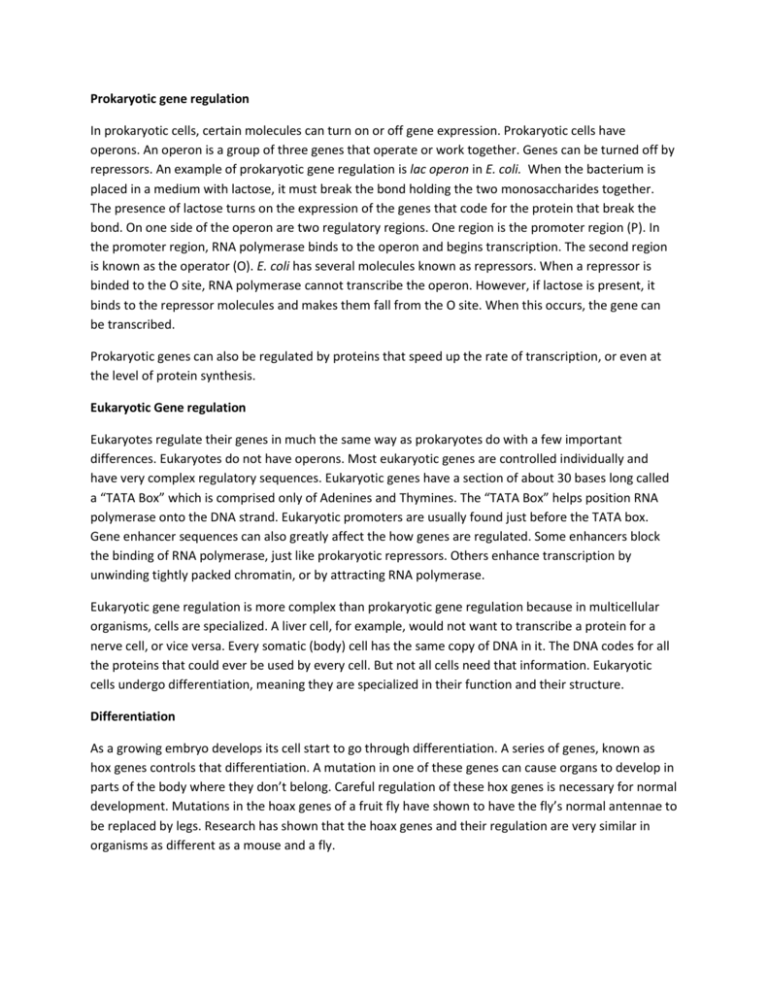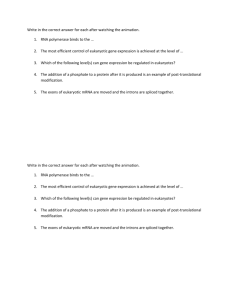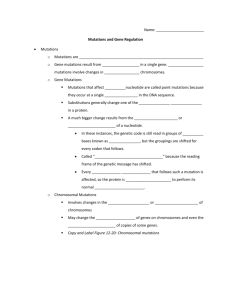Prokaryotic gene regulation In prokaryotic cells, certain molecules
advertisement

Prokaryotic gene regulation In prokaryotic cells, certain molecules can turn on or off gene expression. Prokaryotic cells have operons. An operon is a group of three genes that operate or work together. Genes can be turned off by repressors. An example of prokaryotic gene regulation is lac operon in E. coli. When the bacterium is placed in a medium with lactose, it must break the bond holding the two monosaccharides together. The presence of lactose turns on the expression of the genes that code for the protein that break the bond. On one side of the operon are two regulatory regions. One region is the promoter region (P). In the promoter region, RNA polymerase binds to the operon and begins transcription. The second region is known as the operator (O). E. coli has several molecules known as repressors. When a repressor is binded to the O site, RNA polymerase cannot transcribe the operon. However, if lactose is present, it binds to the repressor molecules and makes them fall from the O site. When this occurs, the gene can be transcribed. Prokaryotic genes can also be regulated by proteins that speed up the rate of transcription, or even at the level of protein synthesis. Eukaryotic Gene regulation Eukaryotes regulate their genes in much the same way as prokaryotes do with a few important differences. Eukaryotes do not have operons. Most eukaryotic genes are controlled individually and have very complex regulatory sequences. Eukaryotic genes have a section of about 30 bases long called a “TATA Box” which is comprised only of Adenines and Thymines. The “TATA Box” helps position RNA polymerase onto the DNA strand. Eukaryotic promoters are usually found just before the TATA box. Gene enhancer sequences can also greatly affect the how genes are regulated. Some enhancers block the binding of RNA polymerase, just like prokaryotic repressors. Others enhance transcription by unwinding tightly packed chromatin, or by attracting RNA polymerase. Eukaryotic gene regulation is more complex than prokaryotic gene regulation because in multicellular organisms, cells are specialized. A liver cell, for example, would not want to transcribe a protein for a nerve cell, or vice versa. Every somatic (body) cell has the same copy of DNA in it. The DNA codes for all the proteins that could ever be used by every cell. But not all cells need that information. Eukaryotic cells undergo differentiation, meaning they are specialized in their function and their structure. Differentiation As a growing embryo develops its cell start to go through differentiation. A series of genes, known as hox genes controls that differentiation. A mutation in one of these genes can cause organs to develop in parts of the body where they don’t belong. Careful regulation of these hox genes is necessary for normal development. Mutations in the hoax genes of a fruit fly have shown to have the fly’s normal antennae to be replaced by legs. Research has shown that the hoax genes and their regulation are very similar in organisms as different as a mouse and a fly. Name: ______________________________ Period: Answer all questions in complete sentences for full credit. Use the reading on the back of this page to answer the questions. 1. What is an operon? 2. What type of biomolecule is lactose? 3. What happens in a promoter region? 4. What happens to the repressor molecule if lactose is present? 5. What is the function of a TATA box? 6. Why is eukaryotic gene regulation more complex that prokaryotic gene regulation? 7. What is differentiation? 8. What set of genes control gene regulation? 9. What are the consequences of a mutation in the hoax gene? 10. What do you think the significance is of the hoax genes being highly conserved across many eukaryotes? ** Bonus ** (+5) What is the difference between A-T binding and C-G binding and how would that maybe contribute to the function of a TATA box (Why isn’t it a GCG box?)









